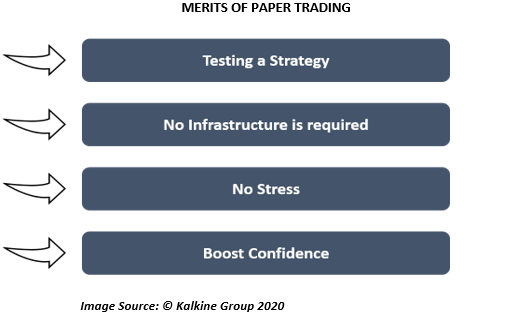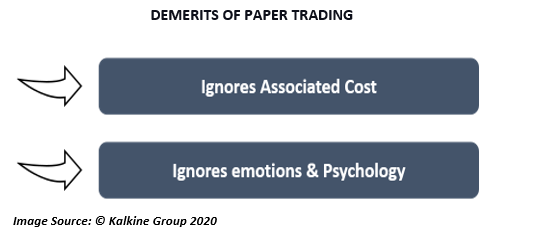Trading is an economic activity which involves buying and selling of goods and services in exchange for money. In the financial market, trading is the same concept; the only difference is it deals with securities, currency, commodity etc.
What is the Significance of Paper Trading for Beginners?
To trade successfully on a consistent basis is not everyone’s cup of tea. Often at times, new traders end up blowing up their entire capital quite early. This happens due to a lot of reasons which are difficult to rectify early on and at once. These hindrances could be lack of knowledge, lack of patience, no prior experience and inability to control the two primary emotions, fear and greed which eventually drive the market etc.
To counter these issues gradually, paper trading is often recommended, especially at the very beginning stage.
What Do We Mean by Paper Trading?
Paper trading, as the name suggests, is a dummy form of trading in which the trades are not executed on an exchange but are written on a paper, which allows investors/traders to hone their trading skills without putting a penny at risk. These trading skills could include the timings of entries and exits, position-sizing, risk management strategies etc.
There is no capital at risk as the trades are only written on paper. But the simulation of these trades is done in accordance with the actual price that is being quoted on the exchange.
With all the hypothetical positions, portfolios and risk but with real price fluctuation, an aspiring trader can learn a lot of things which a mere theoretical book cannot teach. Like any other skill in life, one needs to practice trading in order to improve upon the skill. Paper-trading solves this purpose of practice without putting actual money at risk.
What is the Purpose of Virtual Trading – Technology based paper trading?
With the constant upgradation in technology, nowadays there is an improved version of paper trading called virtual trading. The underlying concept remains the same, to help new traders to practice and improve their trading skills in a simulated environment but with the integration of technology.
In conventional paper trading, the trader continually needs to keep updating prices manually. This could be a tedious task if the frequency of trades is high, especially for intraday trading. Also, a manual log of all the trades needs to be created if the trader wants to look back at the past few trades for any analysis purposes.
Another drawback shows up in the errors. While manually updating prices or another field like net P&L etc. there is a good chance of making a few errors which could lead to the false representation of the P&L.
All these issues are being taken care by technology-based paper trading where all the data feeds are being updated automatically, and live prices are updated. Some of these virtual trading platforms are free while others with advanced features like graphical representation of data or calculation of some advanced metrics etc. can be paid once.
What are the Advantages of Paper trading?
A few of the advantages of paper trading for which it is considered to be one of the best ways to learn to trade in the beginning phase are;

- Testing of a strategy
Before deploying a specific strategy, it is always advisable to first test it. Paper trading helps the trader to test his strategy within a simulated condition which is identical to the live market conditions. This helps to ensure whether the strategy would work or not in the live market. Also, if the strategy fails to work, then the loss will only be virtual as no real money is involved.
- No additional infrastructure required
Virtual trading platforms are quite easily available nowadays. Even some brokers have started to offer this service to their clients. Most of the platforms are free and only requires a sign up to start doing paper trading. No legal documents are required to open a virtual trading account unlike a live trading account.
- No stress
Stress is something which even the best of the traders goes through, especially during the period of losses. As with paper trading, no real money is involved; hence high stress is generally not there.
- Confidence Boost
After a few months, once the trader gets the hang of his strategy, understands the shortcomings of his methodology and strengths and also gains relevant experience, he can confidently start to trade with the real money in the live market.
What are the Disadvantages of Paper Trading?
Despite being such a helpful and effective way to learn to trade, it has some drawbacks too, which must be taken into consideration while paper trading.

- Ignores some associated cost
While paper trading helps to keep track of P&L of individual positions but there are some exclusions from it like brokerage and slippages. Slippage is the difference between the bid and ask price which can reduce the P&L by a meaningful amount, especially when the market is illiquid.
As different brokers charge different brokerages, it is not possible to incorporate it in a trading platform, although it can be written manually.
- Ignores emotions and psychology
If topmost traders of the world were asked to define the single biggest factor which sets a successful trader apart from the crowd, psychology would be heard from most of them. Trading psychology alone can turn a good trading strategy or a specific analysis into a bad one, the sole cause of which is the involvement of money.
Whenever money is at risk in any decision, most of the time, the emotions take over and hamper the ability to think clearly. These two emotions are Greed and Fear.
As there is no money involved in paper trading, these emotions are generally muted and may go onto a completely different level while trading live with real money. This may create a humongous difference between the performance in both the scenarios.
Is there any alternative to paper trading?
To eliminate the drawbacks of paper trading, some traders start directly with the live trading with real money but with a very less quantity. The quantity is so small that the P&L fluctuation is almost meaningless.
This is as good as paper trading but also eliminates the drawbacks of paper trading as trades are executed live on an exchange which accounts for brokerage and slippages and gives realistic P&L figures. Also, money is involved, which helps to practice emotional stability and psychological resilience.
 Please wait processing your request...
Please wait processing your request...